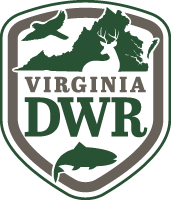For the 2024-2025 Season
By Ben Lewis/DWR
The mourning dove is a popular and abundant game bird in Virginia and across the country. Data from recent years indicate there are around 165 million doves in the United States and around 5 million in Virginia. Population estimates are derived from leg-banding studies and breeding bird surveys conducted in Virginia and throughout the country. Although doves are still quite abundant, we have seen a gradual decline in overall dove numbers over the past 10 years. We are continuing to monitor the population and will take management actions, such as reducing harvest levels, if needed. The reasons for this decline are unclear, but are likely due to the long-term loss of habitat.
Mourning dove hunting is very popular and is offered in 41 U.S. States and several Canadian provinces. In the United States, an estimated 643,000 dove hunters spent around 1,710,000 days afield and harvested around 9.2 million doves during the 2021 hunting season. Recent surveys in Virginia indicate there are around 16,200 dove hunters in the state and the harvest during the 2022-23 season was around 174,000 doves.
Weather Conditions
In 2023, late winter and early spring weather was mild to warm with rainfall amounts generally below average. Doves build shallow nests that can get damaged by wet and windy conditions. Conditions during the breeding season this year were favorable for dove nesting. The Department of Wildlife Resources (DWR) conducts annual summer trapping and leg-banding of mourning doves to monitor population trends and harvest levels. Banding efforts this year indicated fair to good numbers of young doves throughout the state. Overall, production looks like it will be average to slightly above average, which should make for a good dove hunting season.
Habitat Conditions

Dove hunter success often depends not only on the dove populations and nesting success, but also on the condition of the habitat and the amount of food available. Like always, conditions varied around the state, however, in most areas, planting dates for agricultural crops (corn and sunflower) were close to normal this year. A hot and dry period during the month of June led to some stunted and even failed crops in some areas. This drought condition continued in the western portion of the state. Corn harvest dates will likely be close to normal this year, with many areas looking to start the harvest before or soon after Labor Day. In areas where corn is cut for silage, cutting started in early-mid August in most areas.
As the corn harvest increases in early to mid-September, this will open more feeding grounds for doves. This may also spread the birds out across the available habitat and make concentrations of birds harder to find. Some pre-season or in-season scouting may be necessary to help locate areas that doves are using. Look for fresh-cut agricultural fields or areas with lots of native plant foods like millets and pokeberry.
Reminders
Remember to check your birds to see if any are wearing leg bands. DWR, along with other states along the Atlantic Coast, captures and leg-bands doves in July and August, just prior to the hunting season. The information obtained from this banding program is used for evaluating dove population status and for developing hunting season regulations. About 5-8% of the doves we band are recovered by hunters, and most of those recoveries (90%) occur within the state of Virginia. Most band recoveries occur during the first two weeks of the season, and nearly 90% of all recoveries occur during the month of September, an indication that most dove hunting occurs during September.
Out-of-state recoveries of Virginia-banded doves have come predominantly from neighboring states or states in the southeastern U.S., including Maryland, North Carolina, South Carolina, Georgia, Alabama, and a couple from Florida. Recoveries of doves banded in states to the north of Virginia (including New York, Pennsylvania, and Maryland) generally show up a bit later in the season. Remember to report any bands you recover to the Bird Banding Laboratory website. This information is essential for evaluating dove movements and survival. In addition, you will receive a “Certificate of Appreciation” that includes information on where, when, and who banded the dove.
Also, remember that in addition to your hunting license, all migratory bird hunters (even if you are license exempt) are required to get a new HIP (Harvest Information Program) certification each year. You can get the free permit by visiting our website. Plan to do so well before going dove hunting so you aren’t rushed trying to do everything at the last minute. Enjoy your hunting, be safe and good luck!
Ben Lewis is DWR’s migratory game bird biologist.


